
theqspeaksWe just don’t get it — why wouldn’t everyone want to look like this?
Seattle crunches quite a bit of granola, hugs more than its allotted trees, and has the second highest bike commute rate for U.S cities. But, as of yet, it has no bicycle sharing system — which is what all the cool, sustainable cities are doing. (I see you, Tulsa.)
Bikeshares make bicycles available to the public through a network of checkout stations, typically in densely populated areas. They can help cut down on traffic congestion, reduce pollution from cars, and act as the gateway bike for the beginners among us. Oh, and cycling makes us happy. Don’t you want to be happy, Seattle?
Yes, apparently.
In January, the nonprofit Puget Sound Bike Share announced its search for bike vendor proposals in King County, Wash., bringing Seattle one step closer to a bike sharing system. But here’s the problem: No bikeshare has ever been successful where there is a strict helmet law like Seattle’s, which requires cyclists to helmet up regardless of age. (Most municipalities only require children under a certain age to wear a helmet, or have no helmet law.)
If Seattle can pull this off, it will pave a path for cities aiming provide an easy, clean mode of transportation, even while insisting that riders protect their melons.
Helmet laws aren’t the first barricade bikeshare advocates have had to navigate. Early bike sharing programs were curbed because many of the bikes were damaged and stolen. In 2007, Tulsa solved the problem by installing a system that required users to swipe a credit card to use a bike, and tracked where the bikes were checked out and in.
Since then, sharing stations have spread across the U.S. with the ferocity of all those Walmart Supercenters we saw in the mid-’90s — except, you know, better. Already, nearly 30 U.S. cities have them and there are many more in the works. Some programs actually turn a profit.
[protected-iframe id=”990a0cd8d9c9fbb0d7536b686e18a041-5104299-14837186″ info=”https://maps.google.com/maps/ms?ie=UTF8&hl=en&om=1&msa=0&msid=214135271590990954041.00043d80f9456b3416ced&source=embed&ll=43.580391,-42.890625&spn=143.80149,154.6875&t=m&output=embed” width=”470″ height=”400″ frameborder=”0″ scrolling=”no”]
Seattle’s calf-quaking hills and drizzly weather might make you wonder if a program like this can really take off here, but bikeshares are succeeding in similarly dreary, uneven conditions elsewhere. (See Dublin.) The helmet law, on the other hand, could create a real problem. The law by itself could whittle a whopping 30 percent off of bike share participation, according to the Puget Sound Bike Share Business Plan [PDF].
What’s the problem with helmets, you ask? One, helmets can make you look silly and make your hair look worse. Take this guy, for example.
But it’s not just fashion consciousness at work. Some experts say helmet rules make bikes seem more dangerous than they actually are. From the New York Times:
“Pushing helmets really kills cycling and bike-sharing in particular because it promotes a sense of danger that just isn’t justified — in fact, cycling has many health benefits,” says Piet de Jong, a professor in the department of applied finance and actuarial studies at Macquarie University in Sydney. He studied the issue with mathematical modeling, and concludes that the benefits may outweigh the risks by 20 to 1.
Fine odds, professor. Fine odds.
Finally, there’s the question of accessibility. We’ve pretty well figured out how to check out a bike and check it back in, but renting helmets is another can of worms.
Melbourne, Australia, notably tried the bikeshare/helmet law combo and all that resulted was mild interest and several bad cases of helmet hair. According to a 2012 study [PDF] by the Mineta Transportation Institute, the “program’s 600-bicycle fleet averages 70 trips per day, 10 percent the usage of comparable programs in London and Dublin, not accounting for differences in density and land use.”
But Seattle is not Melbourne, says Puget Sound Bike Share Executive Director Holly Houser. Melbourne was unsuccessful, Houser says, because it didn’t clearly communicate to riders that they needed to wear helmets, had a predatory ticketing policy, and didn’t offer helmets at every check-out station.
“We’re looking at having a fully integrated system where there’s a helmet at every kiosk,” Houser adds. If all goes as planned, Seattleites will be able to check out helmets the same way they rent bikes — with the swipe of a credit card. When they’re finished, they’ll turn in the helmet with the bike, so it can be cleaned and inspected. Vancouver, Canada, plans to experiment with a similar system this summer.
However, there is no proposed solution to helmet hair. Maybe they could add hair-gel vending machines too?
Houser says she’s happy to comply with the helmet law: “Everybody involved feels like it’s an important law that we don’t want to see go away.” An oft-cited 1989 study found that the likelihood of head injuries decreased by 85 percent when cyclists were wearing helmets. Houser also notes that Seattle’s topography can lead to faster speeds, and more dangerous, uncomfortable situations for first-time cyclists.
Still, Houser says the larger challenge is to protect cyclists from cars by building a better system of bike lanes, bike paths, and other infrastructure. “The point is to get more people safely on bikes,” she says.
And having more bikes on the street, studies have shown, increases safety by dint of the fact that they’re more visible, and drivers pay closer attention — even if they’re only pointing and laughing at the dudes in the funny plastic hats.




